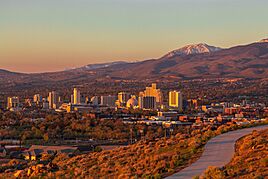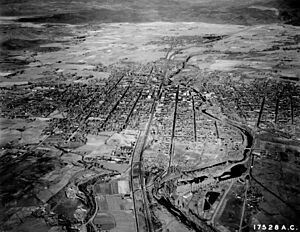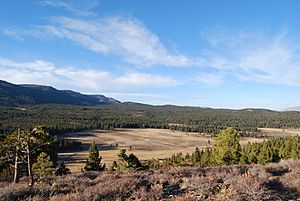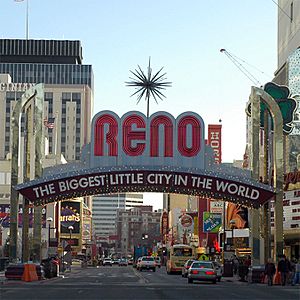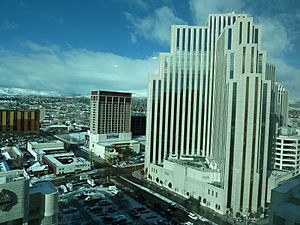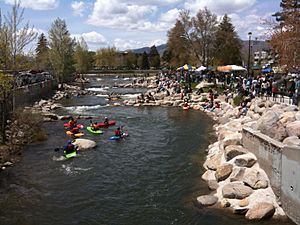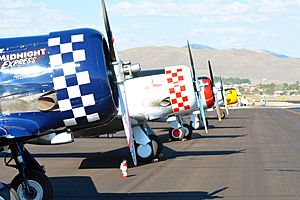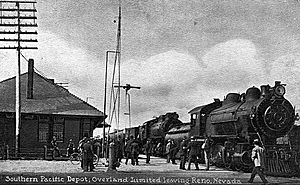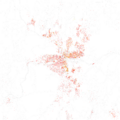Reno, Nevada facts for kids
Quick facts for kids
Reno, Nevada
|
|||||
|---|---|---|---|---|---|
|
Reno skyline
Silver Legacy Resort & Casino
Reno City Hall
Downtown Reno
|
|||||
|
|||||
| Nickname(s):
"The Biggest Little City in the World"
|
|||||
| Country | United States | ||||
| State | Nevada | ||||
| County | Washoe | ||||
| Founded | May 9, 1868 | ||||
| Incorporated | March 16, 1903 | ||||
| Named for | Jesse L. Reno | ||||
| Government | |||||
| • Type | Council–manager | ||||
| Area | |||||
| • City | 111.70 sq mi (289.30 km2) | ||||
| • Land | 108.86 sq mi (281.96 km2) | ||||
| • Water | 2.83 sq mi (7.34 km2) | ||||
| Elevation | 4,505 ft (1,373 m) | ||||
| Population
(2020)
|
|||||
| • City | 264,165 | ||||
| • Rank | 80th in the United States 4th in Nevada (2024) |
||||
| • Density | 2,426.54/sq mi (936.89/km2) | ||||
| • Urban | 446,529 (US: 91st) | ||||
| • Urban density | 2,699.2/sq mi (1,042.2/km2) | ||||
| • Metro | 490,596 (US: 114th) | ||||
| Demonym(s) | Renoites | ||||
| Time zone | UTC−08:00 (PST) | ||||
| • Summer (DST) | UTC−07:00 (PDT) | ||||
| ZIP Codes |
89501-89513, 89515, 89519-89521, 89523, 89533, 89555, 89557, 89570, 89595, 89599
|
||||
| Area code(s) | 775 | ||||
| FIPS code | 32-60600 | ||||
| GNIS feature ID | 0861100 | ||||
| Reference #: | 30 | ||||
Reno is a city in the northwest part of Nevada, a state in the United States. It sits near the border with California. Reno is the main city and largest city in Washoe County. It's located in the Truckee River valley, on the eastern side of the Sierra Nevada mountains. This makes it about 23 miles (37 km) northeast of Lake Tahoe.
Reno is often called "The Biggest Little City in the World." It is the 80th most populated city in the United States. In Nevada, it's the fourth largest city. It's also the biggest city in Nevada outside the Las Vegas Valley. In 2020, about 264,165 people lived there. The city is named after Jesse L. Reno, a brave general from the American Civil War.
Reno is part of a larger area called the Reno–Sparks metropolitan area. This area includes nearby cities like Sparks and Carson City, the state capital. For a long time, Reno was famous for its easy divorce laws. Today, it's a popular place for tourists. People visit for its casino gambling and to enjoy the beautiful Lake Tahoe and Sierra Nevada mountains.
Contents
History of Reno: From Gold Rush to Modern City
Early Days and the Railroad
Long ago, the Martis people lived in the Reno area. By the mid-1850s, some pioneers settled in the Truckee Meadows. This fertile valley had the Truckee River flowing through it. Early settlers helped travelers on the California Trail.
In 1850, gold was found near Virginia City. Then, in 1859, a lot of silver was discovered at the Comstock Lode. This led to a huge "mining rush." Thousands of people moved west, hoping to find their fortune.
To connect Virginia City to the California Trail, Charles W. Fuller built a toll bridge over the Truckee River in 1859. A small town grew around this bridge. Later, Myron C. Lake bought the bridge and added more buildings. He called the place "Lake's Crossing."
The Central Pacific Railroad (CPRR) started building tracks east from California in 1863. They planned to connect with another railroad to create the First transcontinental railroad. Myron C. Lake gave land to the CPRR. In return, they promised to build a train station at Lake's Crossing.
On May 9, 1868, the town of Reno officially began. The railroad superintendent, Charles Crocker, named it after Major General Jesse L. Reno. He was a Union officer who died in the Civil War. In 1871, Reno became the main city for Washoe County. The Virginia and Truckee Railroad also came to Reno in 1872. This helped the city grow as a business and farming center. It became an important stop on the transcontinental railroad.
As mining became less important, Reno and Las Vegas grew. Nevada is still a big producer of gold today.
Reno's Famous Arch and Nickname
The Reno Arch was put up on Virginia Street in 1926. It was to promote a big event called the Transcontinental Highways Exposition in 1927. After the event, the city decided to keep the arch. They asked people to suggest a slogan for it. In 1929, G.A. Burns won with the famous phrase: "Reno, the Biggest Little City in the World."
A Place for New Beginnings
In the early 1900s, Nevada made its laws about ending marriages much easier than other states. By 1931, you only had to live in Reno for six weeks to get a divorce. Because of this, Reno became known as the "Divorce Capital of the World."
Many people, mostly women, came to Reno for a quick divorce. They often called it "the six-week cure." These visitors stayed in hotels and special ranches. This helped Reno's economy a lot. Businesses even offered services like resetting rings for people who had just gotten divorced.
Famous people also came to Reno for divorces. Some of them were Mary Pickford, Jack Dempsey, and Nelson Rockefeller. The city was even featured in movies and books. For example, in the 1939 film The Women, Reno's divorce culture is a big part of the story.
This "divorce business" slowed down in the 1970s. This happened as other states also made their divorce laws easier.
Gambling and Modern Reno
Reno took another big step forward when Nevada made gambling legal on March 19, 1931. This was at the same time the divorce laws were changed. No other state had legal casino gambling like Nevada did then. Casinos like the Bank Club and Palace became very popular.
Soon, the Bank Club was the biggest casino in the world. It was also the state's largest employer. As the divorce business faded, gambling became Reno's main industry. Pioneers like "Pappy" and Harold Smith of Harold's Club and Bill Harrah of Harrah's Casino helped Reno become a top place to gamble for decades.
In the 1980s, rules for Indian gaming became more relaxed. By 2000, new casinos in California started to affect Reno's gambling income.
Today, Reno is also a great place for outdoor activities. It's close to the Sierra Nevada mountains, Lake Tahoe, and many ski resorts. In recent years, big tech companies like Amazon, Tesla, Panasonic, Microsoft, Apple, and Google have invested in the Reno area. This has made Reno a new major technology center in the United States.
The Tesla Gigafactory near Reno is one of the largest buildings in the country. It covers 5.8 million square feet and employs about 11,000 people. In 2023, Tesla announced a huge expansion. This will add more space and jobs, including a new factory for Semis.
Geography and Climate
Reno's Location and Landscape
Reno is just east of the Sierra Nevada mountains. It's on the western edge of the Great Basin. The city is about 4,400 feet (1,341 meters) above sea level. Many faults (cracks in the Earth's crust) are in this area. These faults are linked to the rising of mountain ranges.
In February 2008, a series of earthquakes happened in Reno. The strongest one was 4.9 on the Richter magnitude scale. Many homes were damaged. Nevada is known as a "rockhound's paradise." You can find many cool rocks and minerals like agate, opal, and petrified wood.
Weather in Reno
Reno has a cold semi-arid climate. This means it has moderately cold winters and hot summers. The Sierra Nevada mountains to the west and the dry Great Basin to the east influence its weather. Most rain falls in fall, winter, and spring. Summers are long, hot, and dry.
The average temperature changes a lot between day and night. It can sometimes change by 40°F (22°C) in summer. Reno gets about 6 days a year where the temperature reaches 100°F (38°C) or higher. It also gets about 122 days where the temperature drops to freezing or below. The highest temperature ever recorded was 108°F (42°C). The lowest was -17°F (-27°C).
Reno is often windy. People call the strong northwestern wind the "Washoe Zephyr." Winter snowfall is usually light to moderate. The city averages about 20.9 inches (53 cm) of snow each year. However, snowfall can be much higher in the nearby mountains.
Population and People
Reno's Growing Population
Reno has grown a lot over the years. In 1860, only 1,035 people lived there. By 2020, the population was 264,165.
The city is home to people from many different backgrounds. In 2010, about 74.2% of the people were White. About 2.9% were African American, and 6.3% were Asian. About 24.3% of the population were Hispanic or Latino.
In 2010, there were 90,924 households in Reno. About 29.8% of these households had children under 18. The average household had 2.43 people. The median age in the city was 34.6 years old.
Economy and Jobs
Reno's Main Industries
For a long time, Reno was the gambling capital of the United States. But as Las Vegas grew and Native American gaming became popular in California, Reno's gambling economy changed. Some older casinos closed or became apartments.
Today, larger hotel casinos like the Atlantis, Peppermill, and Grand Sierra Resort are very popular. The Peppermill is known as one of the best gaming hotels in Reno.
Reno hosts many events to attract tourists. These include:
- Hot August Nights (a classic car show)
- Street Vibrations (a motorcycle rally)
- The Great Reno Balloon Race
- Cinco de Mayo celebrations
- bowling tournaments at the National Bowling Stadium
- The Reno Air Races
Reno is also home to the headquarters of several companies. These include Braeburn Capital, Hamilton, and Port of Subs. Companies like International Game Technology and Bally Technologies also have offices here.
Since the early 2000s, many technology companies have moved to the Reno area. This includes big names like Amazon, Tesla, Panasonic, Microsoft, Apple, and Google. The Tesla Gigafactory is a huge factory nearby. It makes batteries and electric vehicles.
Top Employers in Reno
Many people in Reno work for large organizations. Here are some of the top employers:
- Washoe County School District (schools)
- Renown Regional Medical Center (hospital)
- Washoe County (local government)
- Peppermill Reno (casino resort)
- Nugget Casino Resort (casino resort)
- Harrah's Reno Casino (casino)
- Grand Sierra Resort (casino resort)
- Saint Mary's Regional Medical Center (hospital)
- Eldorado Resort Casino (casino resort)
- Silver Legacy Resort Casino (casino resort)
Healthcare in Reno
Reno has several hospitals and healthcare centers. Many of them work with the University of Nevada Reno School of Medicine.
- Northern Nevada Medical Center
- Northern Nevada Sierra Medical Center
- Renown Regional Medical Center
- Saint Mary's Regional Medical Center
- University of Nevada Reno School of Medicine
- Veteran's Administration Sierra Nevada Healthcare System Reno, Nevada
Arts and Culture
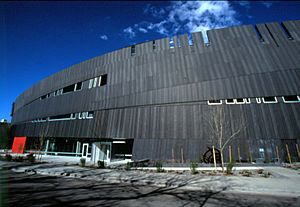
Reno has many interesting museums. The Nevada Museum of Art is the only art museum in Nevada that is officially recognized by the American Alliance of Museums. The National Automobile Museum has over 200 cars. These include a 1973 Cadillac Eldorado that belonged to Elvis Presley.
Reno also has many places for music and performances. These include the Pioneer Center for the Performing Arts and the Reno Philharmonic Orchestra. The Reno Youth Symphony Orchestra is for talented young musicians. They even performed at Carnegie Hall in 2016! A.V.A. Ballet Theatre is the main ballet company at the Pioneer Center.
Every July, Reno celebrates Artown. This is a month-long festival of visual and performing arts. It offers workshops, camps, and classes for all ages. Many events are free or low cost.
Reno has a public library that is part of the Washoe County Library System. The downtown branch is even listed on the National Register of Historic Places.
Sports and Recreation
Reno is home to the Reno Aces, a professional baseball team. They play at Greater Nevada Field downtown. The Aces are part of the Arizona Diamondbacks team. Reno has also hosted many other baseball teams in the past.
In basketball, the Reno Bighorns played at the Reno Events Center from 2008 to 2018. They were connected to the Sacramento Kings.
Reno is also a place for mixed martial arts and boxing events. The famous "Fight of the Century" between Jack Johnson and James J. Jeffries happened in Reno in 1910.
The Reno–Tahoe Open is a big golf tournament held in Reno. It's part of the PGA Tour. The tournament helps raise money for local charities.
Reno also has college sports. The Nevada Wolf Pack teams from the University of Nevada, Reno are very popular. They play in football bowl games and have had top basketball rankings.
In 2004, Reno built a whitewater park on the Truckee River downtown. It's a great place for whitewater activities. The park has different sections for experienced kayakers and beginners.
Reno is home to two roller derby teams: the Battle Born Derby Demons and the Reno Roller Girls. The Battle Born Derby Demons compete nationally.
The National Bowling Stadium is in Reno. It hosts the United States Bowling Congress (USBC) Open Championships every three years.
Fun Outdoor Activities
Reno offers many fun activities all year round. In summer, people enjoy the three main bodies of water: Lake Tahoe, the Truckee River, and Pyramid Lake. The Truckee River flows right through downtown Reno. It's a big part of the Artown festival. Washoe Lake is a great spot for kite and windsurfing because it's often windy.
In winter, skiing and snowboarding are very popular. There are 18 ski resorts close to Reno. Some of the major ones include Northstar California, Palisades Tahoe, and Mount Rose. Other winter activities include snowshoeing and ice skating.
There are also many bike paths for riding in the summer. Lake Tahoe even hosts international bike competitions.
Reno Air Races
The Reno Air Races, also known as the National Championship Air Races, happen every September at the Reno Stead Airport. The year 2023 was the last year for these races in Reno after 60 years.
Education and Learning
Universities and Colleges
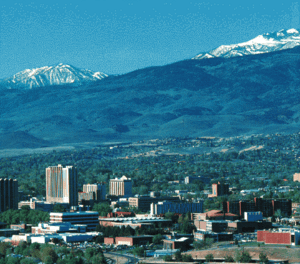
- The University of Nevada, Reno is the oldest university in Nevada. It moved to Reno in 1886. Today, it has over 21,000 students. It's known for programs in mining, agriculture, journalism, and business. It also has one of only two Basque Studies programs in the country. The university is ranked among the top colleges in the nation.
- Truckee Meadows Community College (TMCC) is a two-year college. It has about 13,000 students. TMCC offers many programs, including degrees for transferring to a university or for job training. You can study things like architecture, nursing, and graphic design.
Public Schools in Reno
Public education in Reno is managed by the Washoe County School District.
- Reno has twelve public high schools, including Damonte Ranch, Galena, and Reno.
- There are also three public high schools in nearby Sparks that many Reno students attend: Reed, Spanish Springs, and Sparks High School.
- Reno-Sparks has 15 middle schools and 65 elementary schools.
Public Charter Schools
Reno has many charter schools. These are public schools that have more freedom in how they operate. Some examples include Coral Academy of Science and Davidson Academy.
Private Schools
Reno also has private schools. Some private elementary schools are Legacy Christian School and Nevada Sage Waldorf School. The largest private high schools are Bishop Manogue High School and Sage Ridge School.
Transportation
Roads and Buses
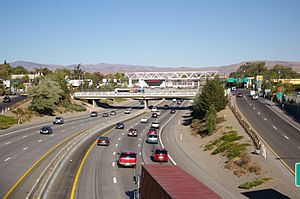
Historically, major highways like the Victory Highway and U.S. Route 40 passed through Reno. Today, Interstate 80 is the main east-west highway. U.S. Route 395/Interstate 580 is the main north-south highway.
The Regional Transportation Commission of Washoe County (RTC) runs the local bus system. It has buses within Reno and to Carson City. They also offer shuttle services for people with disabilities.
Many shuttle services connect the Reno–Tahoe International Airport to other places. You can find shuttles to Lake Tahoe resorts and towns in California.
Trains and Air Travel

Reno was an important stop on the First transcontinental railroad. Today, the Overland Route still runs through Reno. The city has two historic train stations. The Reno station is still active and serves Amtrak passengers. You can take the California Zephyr train from Reno.
The city's main airport is Reno–Tahoe International Airport. It's the second busiest commercial airport in Nevada. Smaller planes use Reno Stead Airport.
Utilities
The Truckee Meadows Water Authority provides drinking water to Reno. The Truckee River is the main source of water. It supplies millions of gallons of water to the city every day.
Sewage treatment for the Reno area happens at the Truckee Meadows Water Reclamation Facility. The cleaned water then goes back into the Truckee River. Golf courses in Reno use this treated water instead of fresh drinking water.
NV Energy provides electricity and natural gas to Reno. Power comes from different sources, including power plants nearby.
Images for kids
| Climate data for Reno (RNO), 1991–2020 normals, extremes 1893–present | |||||||||||||
|---|---|---|---|---|---|---|---|---|---|---|---|---|---|
| Month | Jan | Feb | Mar | Apr | May | Jun | Jul | Aug | Sep | Oct | Nov | Dec | Year |
| Record high °F (°C) | 71 (22) |
75 (24) |
83 (28) |
90 (32) |
98 (37) |
104 (40) |
108 (42) |
105 (41) |
106 (41) |
93 (34) |
77 (25) |
71 (22) |
108 (42) |
| Mean maximum °F (°C) | 61.2 (16.2) |
65.3 (18.5) |
73.9 (23.3) |
80.9 (27.2) |
89.4 (31.9) |
97.0 (36.1) |
102.1 (38.9) |
100.0 (37.8) |
94.5 (34.7) |
85.0 (29.4) |
71.5 (21.9) |
61.7 (16.5) |
102.6 (39.2) |
| Mean daily maximum °F (°C) | 46.7 (8.2) |
51.5 (10.8) |
58.2 (14.6) |
64.7 (18.2) |
74.1 (23.4) |
84.6 (29.2) |
93.4 (34.1) |
91.3 (32.9) |
82.8 (28.2) |
69.8 (21.0) |
55.7 (13.2) |
45.9 (7.7) |
68.2 (20.1) |
| Daily mean °F (°C) | 35.8 (2.1) |
39.6 (4.2) |
45.4 (7.4) |
51.0 (10.6) |
59.8 (15.4) |
68.8 (20.4) |
76.6 (24.8) |
74.3 (23.5) |
65.9 (18.8) |
54.8 (12.7) |
42.7 (5.9) |
35.1 (1.7) |
54.2 (12.3) |
| Mean daily minimum °F (°C) | 24.9 (−3.9) |
27.5 (−2.5) |
32.7 (0.4) |
37.3 (2.9) |
45.6 (7.6) |
53.0 (11.7) |
59.8 (15.4) |
57.3 (14.1) |
49.0 (9.4) |
38.7 (3.7) |
29.8 (−1.2) |
24.2 (−4.3) |
40.0 (4.4) |
| Mean minimum °F (°C) | 12.2 (−11.0) |
15.1 (−9.4) |
21.3 (−5.9) |
26.2 (−3.2) |
34.0 (1.1) |
41.0 (5.0) |
50.7 (10.4) |
48.5 (9.2) |
39.0 (3.9) |
27.4 (−2.6) |
17.4 (−8.1) |
11.3 (−11.5) |
5.6 (−14.7) |
| Record low °F (°C) | −17 (−27) |
−19 (−28) |
−3 (−19) |
13 (−11) |
16 (−9) |
25 (−4) |
33 (1) |
24 (−4) |
20 (−7) |
8 (−13) |
1 (−17) |
−16 (−27) |
−19 (−28) |
| Average precipitation inches (mm) | 1.25 (32) |
1.03 (26) |
0.80 (20) |
0.44 (11) |
0.55 (14) |
0.41 (10) |
0.20 (5.1) |
0.24 (6.1) |
0.21 (5.3) |
0.50 (13) |
0.62 (16) |
1.10 (28) |
7.35 (187) |
| Average snowfall inches (cm) | 5.2 (13) |
5.2 (13) |
2.9 (7.4) |
0.4 (1.0) |
0.1 (0.25) |
0.0 (0.0) |
0.0 (0.0) |
0.0 (0.0) |
0.0 (0.0) |
0.1 (0.25) |
1.8 (4.6) |
5.2 (13) |
20.9 (53) |
| Average precipitation days (≥ 0.01 in) | 6.9 | 7.0 | 5.5 | 4.5 | 4.4 | 3.1 | 1.7 | 1.6 | 2.0 | 2.9 | 4.3 | 6.6 | 50.5 |
| Average snowy days (≥ 0.1 in) | 3.4 | 3.3 | 2.0 | 0.7 | 0.2 | 0.0 | 0.0 | 0.0 | 0.0 | 0.1 | 1.2 | 3.0 | 13.9 |
| Average relative humidity (%) | 68.0 | 60.2 | 52.7 | 45.9 | 43.2 | 39.9 | 36.2 | 39.3 | 44.0 | 50.7 | 61.2 | 67.6 | 50.7 |
| Average dew point °F (°C) | 21.2 (−6.0) |
23.0 (−5.0) |
23.5 (−4.7) |
25.3 (−3.7) |
31.5 (−0.3) |
36.5 (2.5) |
39.6 (4.2) |
39.4 (4.1) |
34.9 (1.6) |
29.5 (−1.4) |
25.3 (−3.7) |
21.0 (−6.1) |
29.2 (−1.5) |
| Mean monthly sunshine hours | 195.6 | 204.2 | 291.0 | 332.1 | 375.8 | 393.8 | 424.0 | 390.8 | 343.9 | 295.2 | 212.0 | 187.5 | 3,645.9 |
| Percent possible sunshine | 65 | 68 | 78 | 83 | 84 | 88 | 93 | 92 | 92 | 85 | 70 | 64 | 82 |
| Source: NOAA (relative humidity, dew points and sun 1961–1990) | |||||||||||||
| Climate data for Stead, 1991–2020 normals | |||||||||||||
|---|---|---|---|---|---|---|---|---|---|---|---|---|---|
| Month | Jan | Feb | Mar | Apr | May | Jun | Jul | Aug | Sep | Oct | Nov | Dec | Year |
| Mean daily maximum °F (°C) | 43.4 (6.3) |
47.2 (8.4) |
53.9 (12.2) |
59.5 (15.3) |
69.0 (20.6) |
79.2 (26.2) |
88.8 (31.6) |
87.1 (30.6) |
79.4 (26.3) |
66.3 (19.1) |
52.4 (11.3) |
43.1 (6.2) |
64.1 (17.8) |
| Daily mean °F (°C) | 33.6 (0.9) |
36.8 (2.7) |
42.3 (5.7) |
47.1 (8.4) |
55.6 (13.1) |
64.1 (17.8) |
72.8 (22.7) |
70.8 (21.6) |
63.5 (17.5) |
51.8 (11.0) |
40.5 (4.7) |
33.4 (0.8) |
51.0 (10.6) |
| Mean daily minimum °F (°C) | 23.9 (−4.5) |
26.4 (−3.1) |
30.6 (−0.8) |
34.7 (1.5) |
42.2 (5.7) |
49.0 (9.4) |
56.9 (13.8) |
54.6 (12.6) |
47.6 (8.7) |
37.2 (2.9) |
28.5 (−1.9) |
23.7 (−4.6) |
37.9 (3.3) |
| Average precipitation inches (mm) | 1.59 (40) |
1.55 (39) |
1.24 (31) |
0.48 (12) |
0.59 (15) |
0.51 (13) |
0.39 (9.9) |
0.19 (4.8) |
0.32 (8.1) |
0.76 (19) |
1.15 (29) |
2.20 (56) |
10.97 (276.8) |
| Average snowfall inches (cm) | 4.0 (10) |
3.1 (7.9) |
2.5 (6.4) |
0.6 (1.5) |
0.1 (0.25) |
0.0 (0.0) |
0.0 (0.0) |
0.0 (0.0) |
0.0 (0.0) |
0.0 (0.0) |
1.0 (2.5) |
5.4 (14) |
16.7 (42.55) |
| Source: NOAA | |||||||||||||
Sister Cities
Reno has several sister cities around the world:
 San Sebastián, Spain
San Sebastián, Spain Taichung, Taiwan
Taichung, Taiwan Udon Thani, Thailand
Udon Thani, Thailand Wirral, England, United Kingdom
Wirral, England, United Kingdom Nalchik, Russian Federation
Nalchik, Russian Federation
See also
 In Spanish: Reno (Nevada) para niños
In Spanish: Reno (Nevada) para niños


